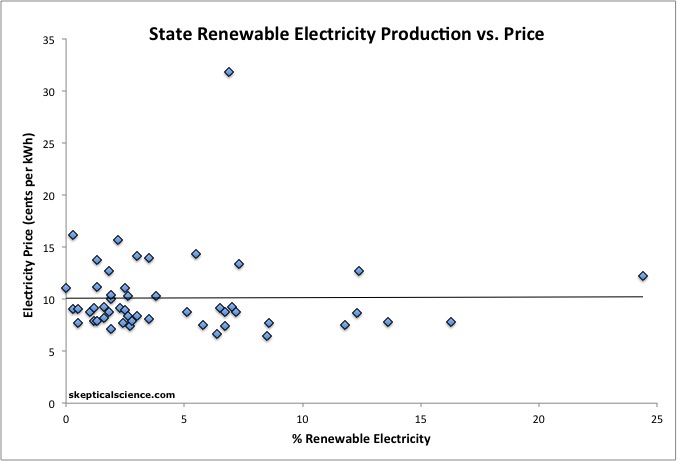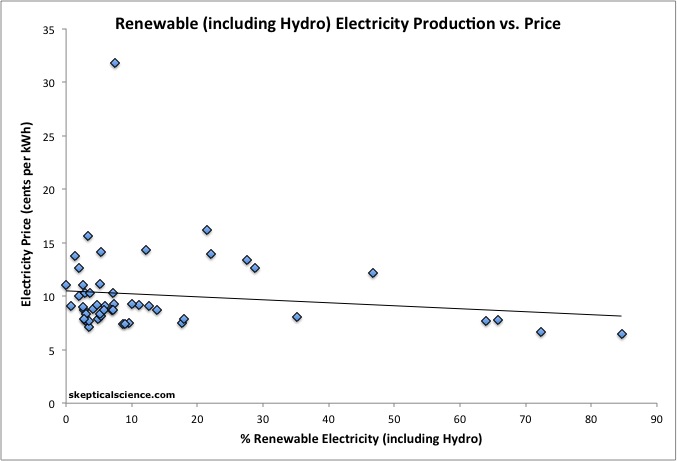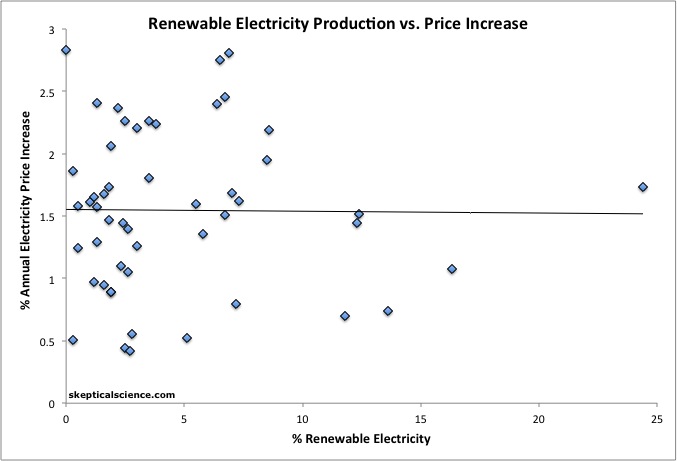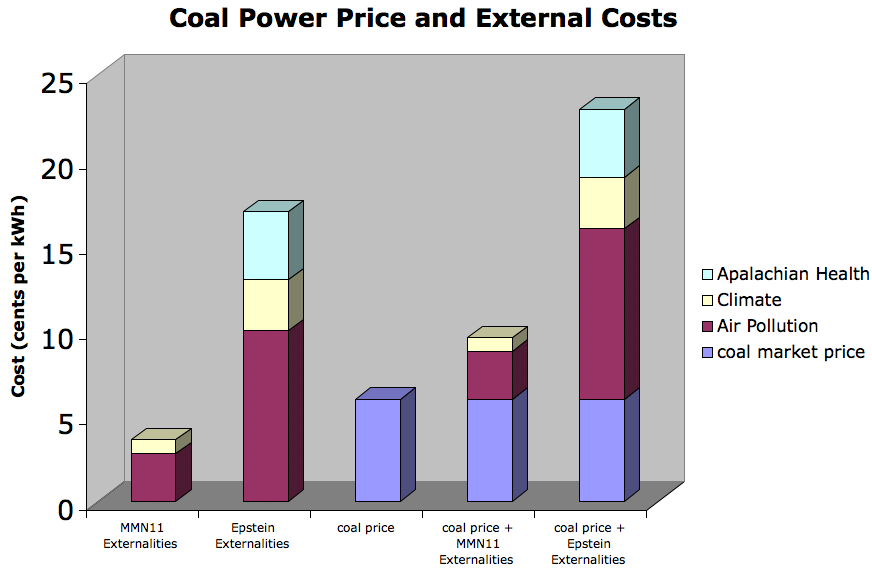Putting an End to the Myth that Renewable Energy is too Expensive
Posted on 3 January 2013 by dana1981
The Washington Post recently published an excellent piece of investigative journalism in which they found that the Heartland Institute has teamed up with the American Legislative Exchange Council (ALEC) in an effort to reverse state renewable energy mandates across the USA. ALEC is a highly controversial organization, essentially comprised of corporations which draft up legislation favorable to their interests, and then pass it along to legislators who will introduce and attempt to implement their bills in state legislatures and US Congress.
The Washington Post reports that ALEC has drafted the Electricity Freedom Act, which would repeal state renewable electricity standards (RESs), which require that a given state meet a certain percentage of its electricity demand with renewable sources by a certain date. For example, California has an RES to supply 33% of its electricity demand with renewables by 2020, and overall 29 states (plus the District of Columbia) have RESs in the USA. A further 7 states have non-mandatory renewable electricity goals (Figure 1).
Figure 1: States with Renewable Electricity Standards and Goals. Source: US Energy Information Administration (EIA).
The Heartland Institute defended the group's efforts to repeal state RESs, calling them "essentially a tax on consumers of electricity" and claiming:
"alternative energy, renewable energy, is more expensive than conventional energy."
In short, the Heartland/ALEC argument is that mandating that electricity comes from renewable sources will raise prices for consumers, and that we should therefore not implement these standards.
There are of course many benefits to implementing renewable energy which this argument neglects, primarily involving reduced pollution — both of traditional pollutants and their human health effects, and greenhouse gases and their climate impacts. But before we address these important neglected points, is it true that deploying renewable energy technologies raises electricity prices? Let's see what the data say.
Renewable Energy Implementation vs. Electricity Prices
To test the Heartland/ALEC claim, we've obtained state renewable electricity generation and electricity price data and from the US Energy Information Administration (EIA). First let's just ask the simplest question — what is the correlation between the percentage of a state's renewable electricity generation and its electricity prices? As Figure 2 shows, the two variables are essentially uncorrelated (correlation of 0.007, to be precise), meaning that a higher percentage of renewable energy generation has not translated to higher electricity prices.
Figure 2: State renewable (excluding hydroelectricity) electricity percentage of total electricity generation vs. electricity price (blue diamonds) with a linear trend (black line). Data from EIA (here and here).
In fact when we include hydroelectricity production in the renewable category, electricity prices actually decline slightly with higher renewable production (Figure 3).
Figure 3: State renewable (including hydroelectricity) electricity percentage of total electricity generation vs. electricity price (blue diamonds) with a linear trend (black line). Data from EIA (here and here).
However, perhaps the states which have implemented more renewable energy started off with lower electricity prices, and perhaps deploying these supposedly more costly energy sources has indeed caused those prices to rise faster than states which continue to rely on fossil fuels.
Alas no, Heartland and ALEC are not saved by this potential nuance. Figure 4 illustrates that there is virtually no correlation (correlation of -0.01) between a state's renewable electricity contribution and its electricity price increase between 1990 and 2011.
Figure 4: State renewable (excluding hydroelectricity) electricity percentage of total electricity generation vs. the percent annual increase in electricity price 1990—2011 (blue diamonds) with a linear trend (black line). Data from EIA (here and here).
Therefore, deploying renewable energy sources has not caused electricity prices to increase in the United States.
What About Subsidies?
Heartland and ALEC would undoubtedly argue that electricity prices have not risen alongside renewable energy deployment due to government subsidies. There may be a sliver of truth to this argument.
- On the one hand, according to an Environmental Law Institute report, in the USA between 2002 and 2008, fossil fuels received approximately 2.5 times more subsidies than renewable energy ($72 billion vs. $29 billion). This also includes transportation fuels, and over half of the renewable subsidies went to corn ethanol, which is not used for electricity production.
- On the other hand, this represents a much larger renewable energy subsidization per unit of electricity produced, since fossil fuels account for a much larger fraction of the overall USA electricity mix (70% vs. 4.1%, respectively, or 70% vs. 10.4% if hydroelectricity is included in the renewable category).
- However, fossil fuels have been receiving government subsidies for over a century, and therefore have received much larger overall government subsidies than renewable sources.
So while renewable energy sources appear to be receiving more government subisides per unit of energy produced than fossil fuels, fossil fuels are receiving larger total subsidies, and have historically received far more subsidies than renewables. And then there are the hidden subsidies.
Carbon — The Huge, Overlooked Fossil Fuel Subsidy
Carbon emissions may reasonably be considered a subsidy because they impose various costs on society via climate change (on agricultural productivity, property damage, human health, etc.), but since most countries don't yet put a price on carbon emissions, these costs are not reflected in the fossil fuel market price. Rather than fossil fuel producers and consumers paying these costs, society as a whole picks up the tab. Therefore, fossil fuel prices are kept artificially low (Figure 5), which is generally the purpose of subsidies.
Figure 5: Average US coal electricity price vs. Muller, Mendelsohn, and Nordhaus (2011) and Epstein et al. (2011) best estimate coal external costs.
The "social cost of carbon" (an estimate of the direct effects of carbon emissions on the economy) remains a highly uncertain cost, but according to a recent study by Johnson and Hope (2012), is somewhere in the ballpark of $100 per ton of CO2 emitted, which is similar to the highest value used in Epstein et al. (2011). Accounting for this cost would add approximately 9 cents per kilowatt-hour (kWh) to the price of coal-generated electricity (which would more than double its market price), or approximately 4 cents per kWh to natural gas. On top of that, there are the other external adverse health effects from coal illustrated in Figure 5, which are not reflected in the market price.
In reality, coal in particular is a very expensive energy source. Unfortunately its true cost is not accurately reflected in its market price, which allows groups like Hearland and ALEC to pretend that it's cheap and that transitioning to renewable energy will be too expensive. In reality, the opposite is true. Continuing to rely on coal is an extremely expensive proposition.
Renewable Energy is Not Expensive
To summarize,
- States with a larger proportion of renewable electricity generation do not have detectably higher electric rates.
- Deploying renewable energy sources has not caused electricity prices to increase in those states any faster than in states which continue to rely on fossil fuels.
- Although renewable sources receive larger direct government subsidies per unit of electricity generation, fossil fuels receive larger net subsidies, and have received far higher total historical subsidies.
- When including indirect subsidies such as the social cost of carbon via climate change, fossil fuels are far more heavily subsidized than renewable energy.
- Therefore, transitioning to renewable energy sources, including with renewable electricity standards, has not caused significant electricity rate increases, and overall will likely save money as compared to continuing to rely on fossil fuels, particularly expensive coal.
Note: this post has been incorporated into the rebuttal to the the myth that renewable energy is too expensive































 Arguments
Arguments


































Since the posts on this article have slowed, I want to add a comment regarding the construction of nuclear power plants, as an uncle of mine has a vast amount of experience in the field, having worked on many nuclear and fossil fuel-fired plants, and I have had many a chat with him over the years. As a civil engineer with expertise in all things concrete, he experienced a rather dramatic situation back in the mid-1980s, I believe, during the construction of a plant in the midwestern US, I think in Illinois.
In the middle of the construction of the critical components of the plant, the government-approved supplier of the high-grade sand required for the high strength mix of concrete ran out of the approved sand (despite having supposedly proven to government inspectors that it had enough such sand in its quarry). As my uncle related the story to those of us gathered around the holiday dinner table, the ensuing delay of several months resulted in a cost overrun in the hundreds of millions of dollars, since all the workers involved in the construction operation were contractually entitled to their pay during the wait for a new source of sand to be approved.
This was merely the biggest and most costly mistake my uncle observed. At different times he pointed out that merely pouring the concrete often involved very costly preparation work and other delays, since many variables--from the exact mix of ingredients to the ambient temperature where it was poured were specified quite exactly in order to guarantee that the concrete would meet the standards. If, for example, the weather was too hot or cold, and there was no way to warm or cool the location of the pour, concrete work had to halt, causing further delays, which in turn often caused additional cost overruns down the line.
At other times, my uncle noted that seemingly minor mistakes or omissions in the enormously complicated plans for the phsyical buildings associated with a power plant proved quite costly. One he cited was failing to include a particular required cable bundle in the specifications which meant that a major steel beam had to be cut out and re-welded, which was nearly impossible to do while still maintaining the required tensile strength. Another happened when, out of thousands of doors spread throughout one new plant, two doors were switched on the blueprints (a sealable, submarine-style door switched places with a standard office door) and the mistake wasn't discovered till after the concrete had been poured. According to my uncle, these kinds of mistakes were rarely easy to fix--usually because of the technical challenges, but also because of the bureaucracy.
Finally, he still laments that the industry continued to build the same basic reactor design for decades, even though better designs were on the drawing board, and then compounded this mistake (as he saw it) by instead focusing on arbitrarily changing the little things--like where to route cables or pipes or where to put offices or stairwells or windows or various control rooms, which meant that mistakes kept cropping up and that costs kept increasing, since despite using the same reactor design, his company never could say it built the same plant twice.
I suppose my main point is that building wind farms and solar arrays is not nearly as fraught with such serious potential problems, and the costs of such projects should continue to come down as the builders of the hardware and the installers gain experience. This cost draw-down clearly won't be as quick to happen with the next generation of nuclear plants, as they are likely to experience a vast number of growing pains due to their much greater level of complexity.
In reply to Mark Harrigon I would like to ask where you are getting your figures from?
The figures from the EIA Levelized cost estimates don't seem to indicate that all renewables are anywhere near the multiples more expensive than fossil fuels as you suggest. For example hydro, geothermal and onshore wind all come out cheaper than coal when all factors, including transmission, are taken into account.
Some renewables are more expensive than fossil fuels, but it is not true across the board as you seemed to assert. And some costs are dropping rapidly e.g. for solar PV.
Indeed, a cheapskate pays twice, and it’s pretty reasonable in this case. Unfortunately, we keep on making it more expensive to preserve the world from complete environmental disaster by trying to save money using the resources we have very doubtful rights. I would like to comment on CBDunkerson who pointed out we all will be fine if we simply go with less CO2 in our everyday life and redistribute the energy from hazardous transportation to safe and clear means. I completely agree, that this is not only the matte of concern of environmentalists and governments, but of each of us. As soon as everyone focuses more on the health of the planet, we will manage it in a collective and effective way. And beware, the world’s plants, like China and India, can’t be responsible for all the pollution issues: it’s us who get obsessed with purchasing and consuming, it’s us who orders more plastic. If you want to make it cheap, try starting from yourselves. For example, when you decide to make your economic standing more stable, you don’t make it through spending more, you simply stop buying, you start saving and, probably, encourage more effective financial operations and address to professionals, like http://loansmob.com/ that can provide you with a viable source to correct your financial reputation. Exactly like that you contribute to the common goal of making environmental activity cheaper – you spend less and save more.